In video games, a power-up is an object that adds temporary benefits or extra abilities to the player character as a game mechanic. This is in contrast to an item, which may or may not have a permanent benefit that can be used at any time chosen by the player. Although often collected directly through touch, power-ups can sometimes only be gained by collecting several related items, such as the floating letters of the word 'EXTEND' in Bubble Bobble. Well known examples of power-ups that have entered popular culture include the power pellets from Pac-Man and the Super Mushroom from Super Mario Bros., which ranked first in UGO Networks' Top 11 Video Game Powerups.

Tyrian is a vertically scrolling shooter developed by Eclipse Software for MS-DOS and published in 1995 by Epic MegaGames. Tyrian was programmed by Jason Emery, illustrated by Daniel Cook, and its music composed by Alexander Brandon and Andras Molnar. The game was re-released as freeware in 2004. A free and open-source port of the game started in April 2007.
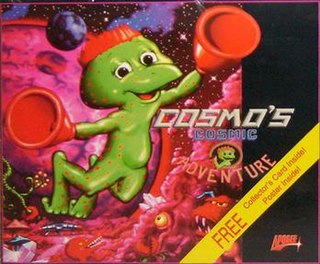
Cosmo's Cosmic Adventure: Forbidden Planet is a video game programmed by Todd Replogle and published by Apogee Software. It is a two-dimensional side-scrolling platform game. The game was released in mid March 1992 for MS-DOS compatible systems.
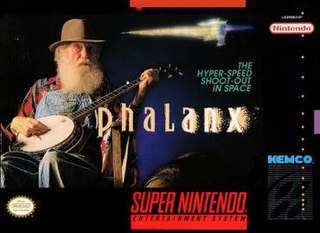
Phalanx is a 1991 horizontally scrolling shooter developed by ZOOM Inc. and Kemco for the Sharp X68000, Super Nintendo Entertainment System and Game Boy Advance. The game was released for the X68000 in Japan in 1991, for the SNES in Japan on August 7, 1992, in North America in October 1992 and in the same year in Europe, as well as for the Game Boy Advance in Japan on October 26, 2001, in Europe on November 23, 2001 and in North America on December 27, 2001.

Steel Empire is a horizontally scrolling shooter released on the Sega Genesis in 1992. Versions for the Game Boy Advance and Nintendo 3DS were released in 2004 and 2014, respectively. The game is scheduled for release on the Nintendo Switch in 2023.
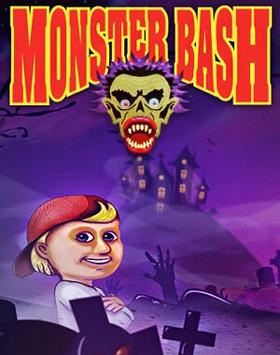
Monster Bash is a side-scrolling platform game developed and published by Apogee Software on 9 April 1993 for DOS. The game features 16-color EGA graphics and IMF AdLib compatible music. It was developed by Frank Maddin and Gerald Lindsly.

Raptor: Call of the Shadows is a vertically scrolling shooter developed by Cygnus Studios and published by Apogee Software. Its working title was "Mercenary 2029". It was released on April 1, 1994 for MS-DOS compatible systems. The first episode of the game, "Bravo Sector", was distributed as shareware. The other two episodes were sold commercially.

Abadox: The Deadly Inner War is a video game for the Nintendo Entertainment System published in Japan in 1989 by Natsume and North America in 1990 by the Milton Bradley Company. It is a horizontally scrolling shooter in the vein of Gradius and R-Type taking place inside the intestinal tract of a giant alien organism. Abadox has a high difficulty, and it takes one hit from an enemy projectile to be killed and restart from a checkpoint passed before death.

Bio Menace is a 1993 game developed and published by Apogee Software for MS-DOS. A 2D multidirectional scrolling platform game, it was built on a licensed version of id Software's Commander Keen game engine. Apart from the engine and music, all in-game content was created by the game's designer, Jim Norwood. In 2014, the game was re-released on Steam, and in 2015 on GOG.com with support for Microsoft Windows, macOS, and Linux.
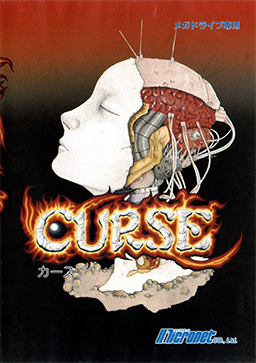
Curse is a 1989 video game developed by Micronet for the Mega Drive video game console. It is a horizontally scrolling shooter with five levels. Although an American release was planned, it was never officially released outside Japan.
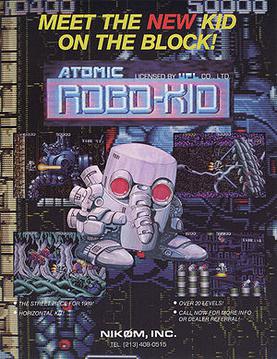
Atomic Robo-Kid (アトミック・ロボキッド) is a horizontally scrolling shooter released in arcades by UPL in 1988. In the US, the game was published by Nikom. The PC Engine version is an adaptation of the arcade original and published as Atomic Robo-Kid Special.

TwinBee 3: Poko Poko Daimaō is a vertical-scrolling shoot 'em up video game produced by Konami originally released for the Family Computer in 1989. It was the third game in the TwinBee series released for the Famicom, following the home version of the original TwinBee and the Famicom-exclusive Moero TwinBee. Unlike Moero, which was released in North America as Stinger, TwinBee 3 was a Japan-only release. It was re-released on April 14, 2006 as part of the i-Revo downloadable game service.
Shienryū (紫炎龍) is a vertical scrolling shooter created by Warashi for the arcade which was released in 1997, later followed by a Sega Saturn console release in 1997 and PlayStation release in 1999 (JP) and 2002 (US).
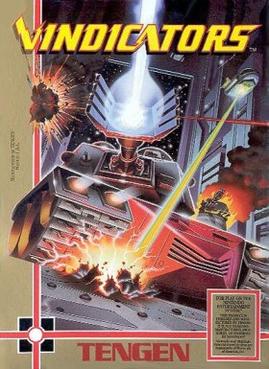
Vindicators is an arcade video game released by Atari Games in 1988. One or two players each control a tank in a multidirectional scrolling level. Home ports were by Tengen. Vindicators was not licensed by Nintendo and used an alternate chip to defeat the 10NES lockout system. Ports were planned for the Atari Lynx and Apple IIGS, with the latter even completed, but both were cancelled. Vindicators was followed by the lesser known arcade sequel, Vindicators Part II.
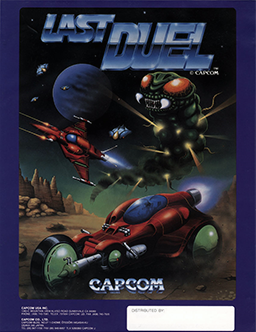
Last Duel: Inter Planet War 2012 is a vertically scrolling shooter released in arcades by Capcom in 1988. It was ported to the Amiga, Amstrad CPC, Atari ST, Commodore 64, and ZX Spectrum.

Zed Blade is a horizontally scrolling shooter arcade video game developed by NMK and originally published by SNK on September 13, 1994. It is the only game created by NMK for the Neo Geo arcade platform. In a science fiction setting, players choose one of three characters to attempt to overthrow an army of enemies led by the on-board supercomputer at the automated Yggdrasil space station and seize full control of it once again.

Dariusburst is a horizontal scrolling shooter developed by Pyramid and published by Taito. Forming part of the Darius series, it was released for the PlayStation Portable on December 24, 2009. Like previous Darius games, Dariusburst is an offbeat sci-fi shooter set in outer space with aquatic-themed robotic enemies. In keeping with tradition, the game also features branching paths instead of the linear progression found in most games of the genre. There are a total of 11 zones in the game, with 5 stages per run.

"GENETOS" is a freeware vertical shooter game or "shoot 'em up" developed and published by Tatsuya Koyama with an "evolution" theme. In GENETOS, the levels represent different generations in the evolution of shooting games.

Gateworld: The Home Planet is a platform game developed and published by Homebrew Software and released in 1993. This game was Homebrew Software's first software product. There are three episodes of 12 levels each, the first available as shareware.

Terra Cresta II: Mandler's Counterattack is a vertically scrolling shooter video game developed by Make Software and published by Nichibutsu for the PC Engine Console. It is the third installment to the Cresta series and a sequel to the 1985 Arcade Game Terra Cresta. It is only released on Japan on November 27, 1992.



















